Flexible linking of machines by buffering capacity conveyor systems
02.07.2020
Happ Kunststoffspritzgusswerk und Formenbau GmbH is a wellknown manufacturer of parts and assemblies for the automotive industry based in Ruppichteroth, North Rhine-Westphalia, Germany. The equipment used to make these products includes several injection molding machines of the all-electric EcoPower series from WITTMANN BATTENFELD. Flexible linking together of two of these machines by conveyor systems with buffering capacity from the Happ subsidiary ErgoTek enables efficient production of complex assemblies with a guarantee of highest
possible quality standards.
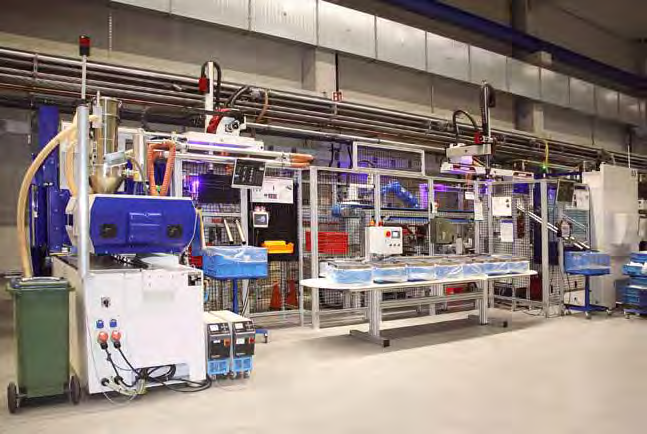
General view of the EcoPower 110/350 injection molding machines from WITTMANN BATTENFELD linked together by conveyor systems with buffer capacity.
Happ was established in 1964. Its first products were sandwich boxes and furniture fittings. The family-owned and owner-managed company based in Ruppichteroth currently employs 70 workers making high-quality, complex parts and assemblies primarily for the automotive industry in three shifts on a 6,000 square meter production floor. Some of the company’s sales are also realized with products for white goods. Happ offers its customers the complete portfolio of goods and services ranging from product development and design and in-house moldmaking all the way to prototyping and series production. The company processes more than 1,300 t of many different types of thermoplastics with shot weights ranging from 0.5 to 3,000 g by 1- and 2-component injection molding. About 40 injection molding machines with clamping forces from 350 to 8,000 kN are available for producing the plastic components, of which 7 are all-electric EcoPower machines from WITTMANN BATTENFELD in the 1,000 to 3,000 kN clamping force range.
Most of the molding machines from the EcoPower series are equipped with W818 and W822 robots from WITTMANN. To dry its materials, Happ uses a central material drying system from WITTMANN.
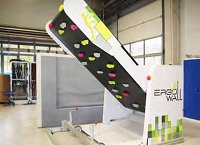 Thanks to continuous investment in innovative automation technology, Happ is able to put together complete assemblies fully automatically and consequently with ultimate precision and efficiency. To develop and manufacture these automation solutions, Happ established the company ErgoTek at its domicile in Ruppichteroth in 2015.
Thanks to continuous investment in innovative automation technology, Happ is able to put together complete assemblies fully automatically and consequently with ultimate precision and efficiency. To develop and manufacture these automation solutions, Happ established the company ErgoTek at its domicile in Ruppichteroth in 2015.
The foundation of ErgoTek originated from a product developed by Happ in 2014 for the fitness and physiotherapy sector by the name of Ergo-Wall. This is a climbing wall which can be set at different tilt angles using automation and conveyor technology. At the University of Potsdam, the Ergo-Wall is now being used to train physiotherapists.
Clocked systems versus systems with buffering capacity
Happ then decided to have ErgoTek utilize the knowledge gained with this product not only for assembly work on its own production floor, but for other industries as well. The conveyor systems developed by Happ consist of plastic modules that since 2018 have been used in industrial environments. Classic module conveyors have bearing units that are fixed to the conveyor chain, this means they are clocked systems.
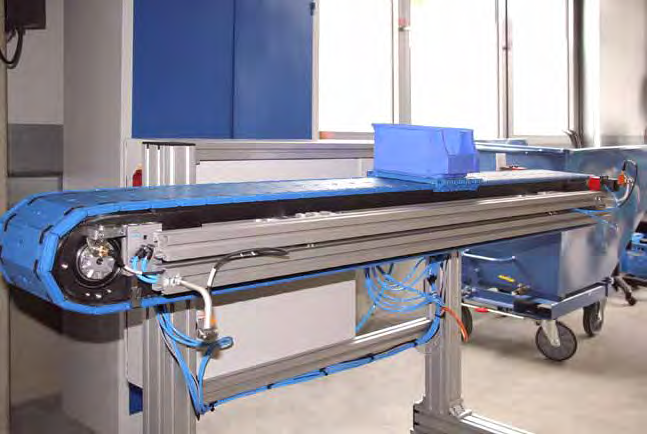
Flexi conveyor (testing appliance) from ErgoTek consisting of plastic parts made by Happ
In 2019, the modular conveyors, primarily used for clocked systems, were supplemented by the FlexiTek system. FlexiTek systems are forwarding the bearing units on the basis of their self-weight. Thus it is possible to store or buffer within the conveying process where it becomes necessary. These FlexiTek systems with buffering capacity are suitable for a great variety of applications and optimally adapted to the requirements in injection molding production. For the current year, an extension of the portfolio is planned, to include a heavy-load conveyor system for lattice boxes.
Basically, the development of the conveyor modules is based on two pillars: the competence of Happ in the field of plastic injection molding production, and the company’s many years of experience in conveying and automation technology. This finally has led to the development of modules that the ErgoTek company can use flexibly and in a modular way in conveyor technology systems. Here, special attention is paid to the products’ cost-efficiency.
Flexible linking of two injection molding machines
A project recently completed by ErgoTek in the company’s own production is the flexible linking of two EcoPower machines by conveying systems with buffer capacity. With this system, the outer and inner tubes of oil filter drain screws for the automotive industry are fully automatically assembled, inspected, laser-printed and deposited.
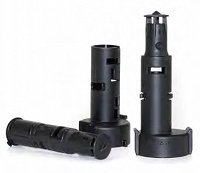 In this system, two EcoPower 110/350 machines are integrated, both with 1,100 kN clamping force and each equipped with a W818 robot from WITTMANN. On these machines, the inner and outer tubes of the oil filter drain screw are injection-molded, each with a 2-cavity mold, then removed by the WITTMANN robots and presented to a camera to check the parts’ dimensional accuracy. Another camera examines the parts for burr formation. Next, the tubes are transported further by FlexiTek conveyors from ErgoTek and buffered for cooling. Then, a SCARA robot fits the outer tube onto the inner tube. With the help of an articulated robot and a further camera check, the depth gauge and angular position are measured, and subsequently the parts are transferred to a labeling band for laser printing. From there, the finished components are transferred to the Flexi buffer from ErgoTek.
In this system, two EcoPower 110/350 machines are integrated, both with 1,100 kN clamping force and each equipped with a W818 robot from WITTMANN. On these machines, the inner and outer tubes of the oil filter drain screw are injection-molded, each with a 2-cavity mold, then removed by the WITTMANN robots and presented to a camera to check the parts’ dimensional accuracy. Another camera examines the parts for burr formation. Next, the tubes are transported further by FlexiTek conveyors from ErgoTek and buffered for cooling. Then, a SCARA robot fits the outer tube onto the inner tube. With the help of an articulated robot and a further camera check, the depth gauge and angular position are measured, and subsequently the parts are transferred to a labeling band for laser printing. From there, the finished components are transferred to the Flexi buffer from ErgoTek.
Using this clocked system has finally made cost-efficient manufacturing of this product possible. But the production cell offers a number of other advantages as well:
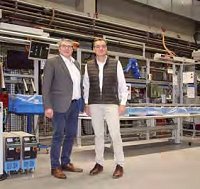 Thanks to interlinking the two parts of the system via the FlexiTek conveyor belts, storage of the individual parts can be dispensed with, and the allocation of cavities and consequently traceability remain ensured.
Thanks to interlinking the two parts of the system via the FlexiTek conveyor belts, storage of the individual parts can be dispensed with, and the allocation of cavities and consequently traceability remain ensured.
• SPC parts can be requested and removed via the chutes.
• If an interruption occurs on one system component, the other components can continue their production for up to a maximum of one hour.
• The box buffer with the finished parts only needs to be emptied about every 2.5 hours.
• The linkage of the FlexiTek conveyor belts requires only a minimal control effort and permits separation of the individual safety areas from each other.
Happ has been relying on technology from WITTMANN BATTENFELD for over 15 years. What is specially appreciated at Happ and ErgoTek is the robustness and simple operation as well as the easy extensibility of WITTMANN BATTENFELD equipment, in addition to the excellent service. Dirk Wevelsiep, Sales Manager at ErgoTek, comments: “Thanks to their easy extensibility, the injection molding machines from WITTMANN BATTENFELD are ideally suited for intelligent linkage. And when it comes to aftersales service, WITTMANN BATTENFELD is also in a strong position.”





































